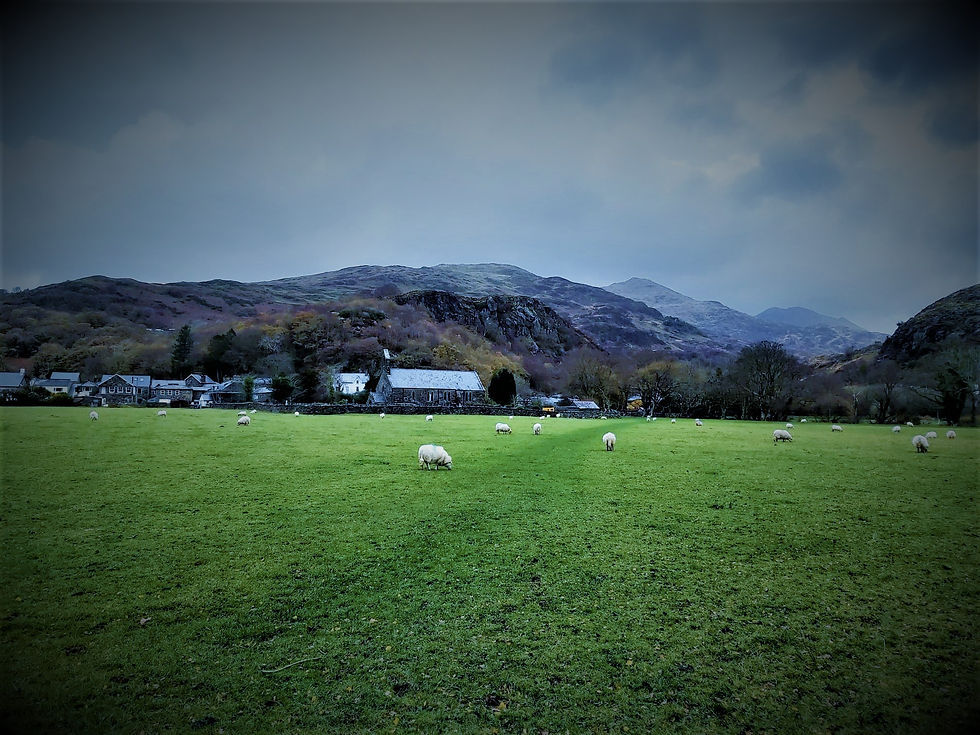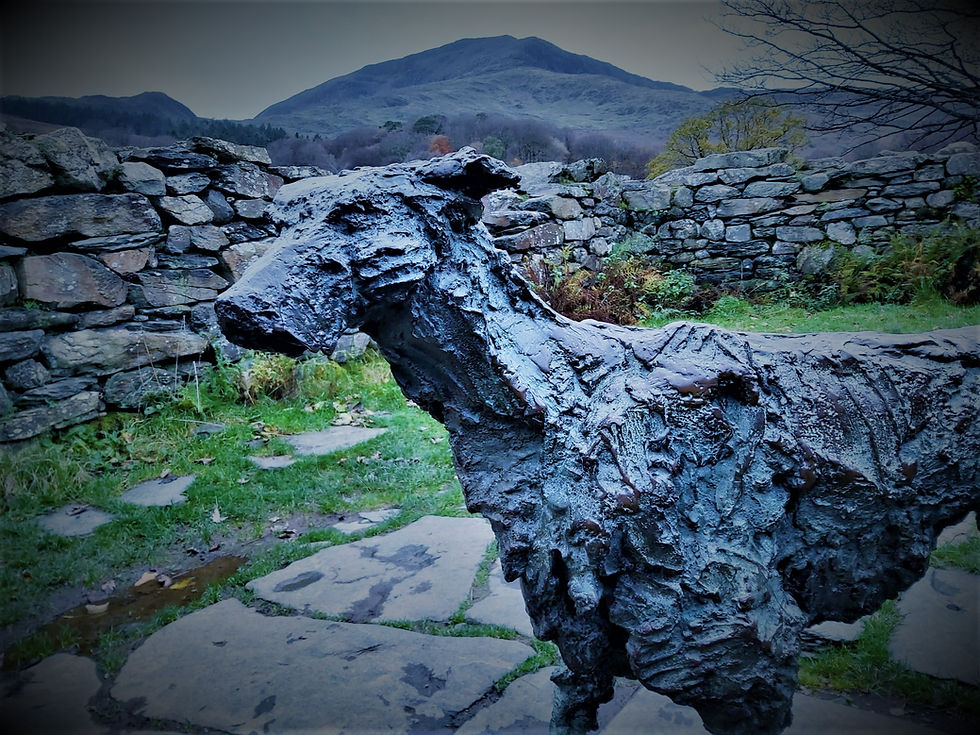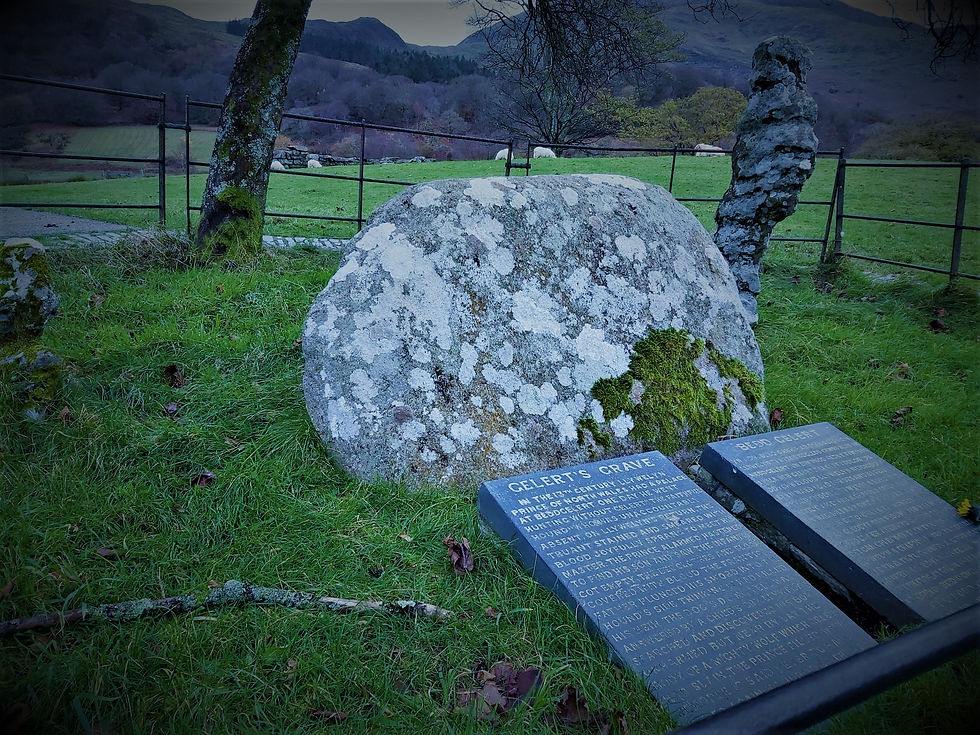WHERE THE FOLK can I find Space Rock and a Martyred Mongoose?
- Russ Williams

- Nov 16, 2020
- 9 min read
Updated: Feb 23, 2022

WE ALL KNOW THIS ONE- the one about the man who regrettably kills his loyal dog due to a misinterpretation. But the reason why so many of us are familiar with this tale may yet surprise you…
Beddgelert, or ‘Begel’, for the local youth, was once a big part of my life, and I still visit the place a couple of times a year. The last time I was there was New Year’s Eve. What a night! I played Tour Guide for three friends of mine from Cardiff, after telling them that Beddgelert held the BEST NYE, with dancing on the bridge, a DJ set up in the street, all the pubs rammed with their fires burning, a crazy parade at midnight with a different theme each time, and people jumping into the river- and they must have been impressed, for the next morning, they booked to go the following year! I made big promises to be less anti-social in the new year, to ‘get out there’ more and make better use of my free time- we all know how that worked out in 2020… I remember, once, they had a full-size Tardis standing in the river, which they set alight at midnight and we all locked arms, swayed and sang ‘Auld Lang Syne’ like something out of the Wicker Man.

Today, I’ve stopped here to stretch my legs after a long drive up the A470, on my way home for the weekend. I make this trip several times a year- it’s a good four-hour drive to my home village from Cardiff, unless you get stuck behind any lorries, caravans or tractors, in which case it takes longer, and you get to see a lot of sights along the way, with a lot of tales and rumours to go with them, which I shall touch upon more in a future post… but when I turn off and drive up the A487 then the A498 however, the sights, for me, get even better, for they are familiar and they are close to my heart, because it is here at Snowdonia, in Gwynedd, that I was raised. These mountains watched me grow, and have always been in the background of some of my best childhood memories.
Then the hills around Beddgelert, bless them, got to see my teenage years. I got a job in a café here a couple of weeks before my thirteenth birthday, and I ended up working there for nearly a decade- I even moved into the flat upstairs at one point, then worked the bar at the pub next door.

The village pretty much survives off the pubs, cafes, shops, guesthouses and restaurants which align its pretty, postcard-perfect streets. Honestly, it’s like the village in Hot Fuzz! As such, the place has won numerous floral competitions in the past- expect hanging baskets, ramblers and parking nightmares.
The place seems to attract the attention of the media quite a bit as well, with films like The Inn of the Sixth Happiness and Tomb Raider 2: Lara Croft and the Cradle of Life being filmed here. Midsummer Murders was shot here once, and I even spotted Victor Meld- ah, Richard Wilson standing outside the village’s famous ice cream parlour, on a break whilst filming a documentary. Alfred Bestall also wrote and illustrated some of the Rupert the Bear stories whilst he lived here (the original Rupert the Bear was released in 1920 by the way, making this year its 100th anniversary). These days, the village often gets in the media for the big lorries that keep getting stuck on the bridge, led there by GPS.
The population taken at the 2011 census was 455, though any local will tell you that a great deal of the village consists of holiday homes, which often sit empty in the bleak winter months, during which time many local businesses shut, before re-opening again come Easter. There can be no bigger contrast than the quiet ghost town of winter and the bustling Beddgelert of summer, honestly! But the nature of the industry makes the village a hotspot for local teens from neighbouring villages, such as myself back then, to seek work between educational terms.

I hold many of the locals close to my heart… I used to love listening to their stories when I worked the bar- old men with pipes, all poking at the fire and longing for a time that never was. They told me about the meteorite that crashed there on September 21st, 1949. It came through the roof of the Prince Llywelyn Hotel early in the morning and made local headlines, then Durham University put an ad up in the papers offering a reward to anyone who brought them a fragment of the space rock. Eager to make the most of the situation, or more likely, so that he could fix his roof, Mr Tillotson, the hotel owner, sold them the meteorite- well, half for them, and the other half for the British Museum. Strangely, there have only ever been two such recorded meteorite falls in Wales- the other happened just fourteen miles away at Pontllyfni, in 1931.
But the reason why crowds of visitors from all over the world come to Beddgelert every year does not involve meteorites, Rupert the Bear nor a burning Tardis, though we can thank another hotel owner for it…

The story goes that, around the year 1200, Llewelyn the Great (c. 1173- 11th April 1240), or ‘Llywelyn Fawr’, for us Welsh, King of Gwynedd and eventually all of Wales, along with his wife Joanna, were living in Aber with their new-born son. They loved hunting down wolves in the surrounding woodland with their pack of hounds- one of whom, Gelert, Llywelyn loved as much as his own blood. He was his most loyal greyhound, and the strongest and the fastest of the pack.
One day, the husband and wife pair went out on a wolf hunt and tucked their baby boy away safely in his cradle, as they always did. When the hunt was over, they sounded the signal for them all to return to the lodge, but Gelert was nowhere to be found…

Back home, they found the place a bloody mess, with their new-born child nowhere to be found, and there was Gelert- lying on the cradle with blood dripping from his mouth. Devastated, blinded by rage, Llywelyn sank his sword deep into Gelert’s heart, killing him instantly. But when the poor dog yelped, it startled Llywelyn’s son, who started crying from underneath the upturned cradle. Llywelyn lifted the cradle and found his son, alive and well. Talk about having a ‘Man Look’… even better, that’s when he saw the wolf’s body lying on the flagstones! It suddenly dawned on him what had actually happened- Gelert had chased a wolf back to the house and killed it so to defend the boy!
Llywelyn was GUTTED, to say the least, so he buried ol’ Gelert down by the river and named the village ‘Beddgelert’, or ‘Gelert’s Grave’, in his honour. And it was said that Llywelyn never smiled again. Today, you can go see Gelert’s grave, where they’ve put up a plaque which tells the story.

However, by now, it is no secret that that gravesite was not laid by Llywelyn Fawr, at all- in fact, a South Walian by the name of ‘David Pritchard’ set it all up after moving to Beddgelert in 1793. Struggling as the new landlord of the Goat Hotel, he devised a plan to attract tourists to the area, and so, he put forth the story about Llywelyn and his martyred greyhound and, by 1800, the story had gone viral, made accessible by the poet William Spenser, who wrote ‘The Grave of the Greyhound’ after he stayed at the Goat that year. I can picture the two of them now, scheming over the hotel bar after hours, all drunk and green-eyed... the Victorian Era’s upper class that came after that lapped it right up, thanks to the release of Lady Charlotte Guest’s The Mabinogion, which sparked a new interest in Celtic folklore and romanticism. Thus, Beddgelert grew into the popular tourist spot we all know it to be today.
But this conspiracy goes deeper than that- MUCH deeper…

A story very similar to that one appeared way before the days of David Pritchard, at around 1592; ‘Fabula de Beth Kilhart’. It told of how Llywelyn and Johanna bought a dog from England matching the description of Gelert, whose name was ‘Kill-hart’, and took him to Gwynedd to hunt a hart/stag. Ultimately, the hart and the dog both died.
Now, it is said that the dog was buried at a ‘Bethkilhart’. But what’s interesting, is that the story was apparently taken from an early thirteenth-century manuscript, back when Llywelyn Fawr was alive, meaning he could have potentially told the story himself!
Does this mean that the ‘made-up’ story devised to attract visitors in the late 1700s isn’t fabricated, at all?
That might be a possibility, were it not for the fact that the story had already been told all over the world numerous times before, the earliest example originates from India, way back in the 5th Century…
‘The Brahmin’s Wife and the Mongoose’ tells of a husband and wife with an only son and a pet mongoose. One day, the wife asks her husband to watch the boy so that she can go fetch some water. However, the husband goes out to beg for food, instead. During that time, a cobra enters the house and goes to kill the boy, and the mongoose bravely battles the snake, ultimately killing it. Proud of its achievement, it goes to show the wife what he’s done. But when she sees the blood on his face, she immediately assumes that he’s killed her only son, and drops the jug of water on him, killing him instantly. Then, of course, she eventually realizes her mistake, and she damns her husband for being so greedy.

The tale spread across the globe, and as different cultures adopted it, different animals took the starring role. In Persia, the mongoose was replaced by a cat, then a bear in Malaysia, a sheepdog in Austria, and so forth… Egypt even replaced the mongoose with a human saint!
The Indian Panchatantra dates as far back as the early oral traditions of story-telling of 300 B.C, and then some- truly a timeless classic!
Then, of course, the tradition carried on after Llywelyn Fawr’s time- in the fifteenth century, John Rous, in ‘Rous Roll’, described the arms of Wales as that of a dog and a cradle sitting on top of a helmet. John Rous was an English historian who wrote Rous Roll during the reign of Richard III (1483-1485). In it, he portrays Dick as a nice guy, but quickly changes his mind when the Welshman Henry VII took the throne, calling him a disfigured freak.
Then in 1894, Rudyard Kipling wrote The Jungle Book, which featured a short story about a heroic Indian mongoose named 'Rikki-Tikki-Tavi' who defends his family from a pair of vengeful cobras.
Some people even compare Disney’s Lady and the Tramp to the tale! But now the story is evolving, adapting to a new audience… in 2002, Canadian television series ‘Incredible Story Studios’ made a short film called ‘The Return of Gelert’, written by a Welsh schoolgirl, which tells of Gelert returning to Beddgelert as a ghost- another example of the reinvention of a folktale.
But what of the actual origins of the name ‘Beddgelert’, then?! Not only is the famous story not true, but the village already had a similar name when the story was told- both in Llywelyn Fawr’s time and David Pritchard’s!
It is widely believed that the name is linked to Saint Gelert (or Celert/Celer), as are several other place-names in Wales, including Gelert Valley and Llangeler (Gelert’s Church).
Saint Gelert was a 7th Century loner who lived in a cave, now known as the ‘Holy Well of St Celer’, near Llandysul, from where he would heal weary pilgrims of their ailments. Eventually, a church called Capel Mair was built over the well, though its foundations still remain.
The Saint then chose to ‘Spread the Good Word’ across Wales, or to Llangeler and Beddgelert, at least… some people believe that he was then martyred in Beddgelert, although, historians are debating this, blaming the misconception on… wait for it… the village’s name- which brings us right back to square one!
So… Where The Folk did Beddgelert get its name from?! And where is the REAL martyr’s grave located, if there is one?
Who knows. But for now, it’s homeward bound for me…

-VERY VOLKAL-
Wherever the story’s origins may lay, and despite the fact that most people already accept it not to be true, people still hold the tale of the man who killed his loyal companion close to their hearts. Why is this, do you think? Why does is resonate so much with people of all cultures and religions?
Also, has anyone else got a story about Beddgelert that they’d like to share?
Diolch,
Russ
REFERENCES:
"Gelert - About us". Gelert. Retrieved 7 June 2016.
^ "The Legend of Gelert the Dog". Historic UK.
Fabula de Beth Kelhart (1592)
Guest, Lady Charlotte (1838-1845) The Mabinogion
Kipling, Rudyard (1894) The Jungle Book
Panchatatantra (5th Century)
Pritchard, David (1793) The Grave of the Greyhound
Rous, John (1483-1485) Rous Roll
Rupert the Bear (1920 & 1935) Mary Tourtel & Alfred Bestall
Stevenson, Peter (2017), Welsh Folk Tales






















Interesting read, keep up the good work!
Diolch Terry, nes i ddysgu dipyn yn neud hwn!
Diddorol iawn Russ.
Thanks for reading, guys.. people still hold the tale of the man who killed his loyal companion close to their hearts- why is this, do you think? Why does is resonate so much with people of all cultures and religions? Also, has anyone else got a story about Beddgelert that they’d like to share? Diolch, Russ